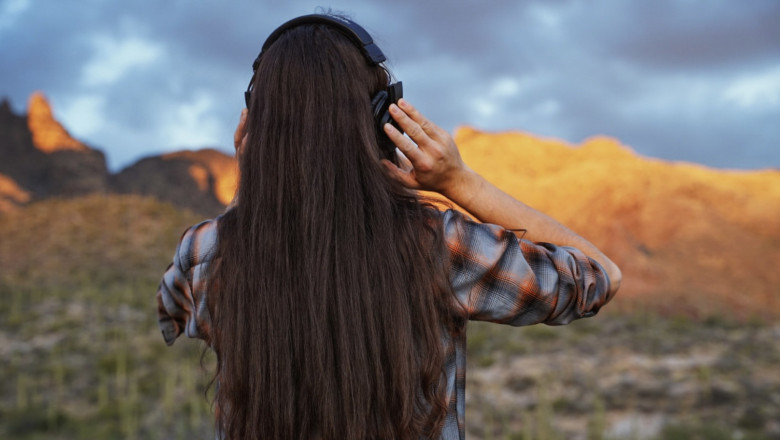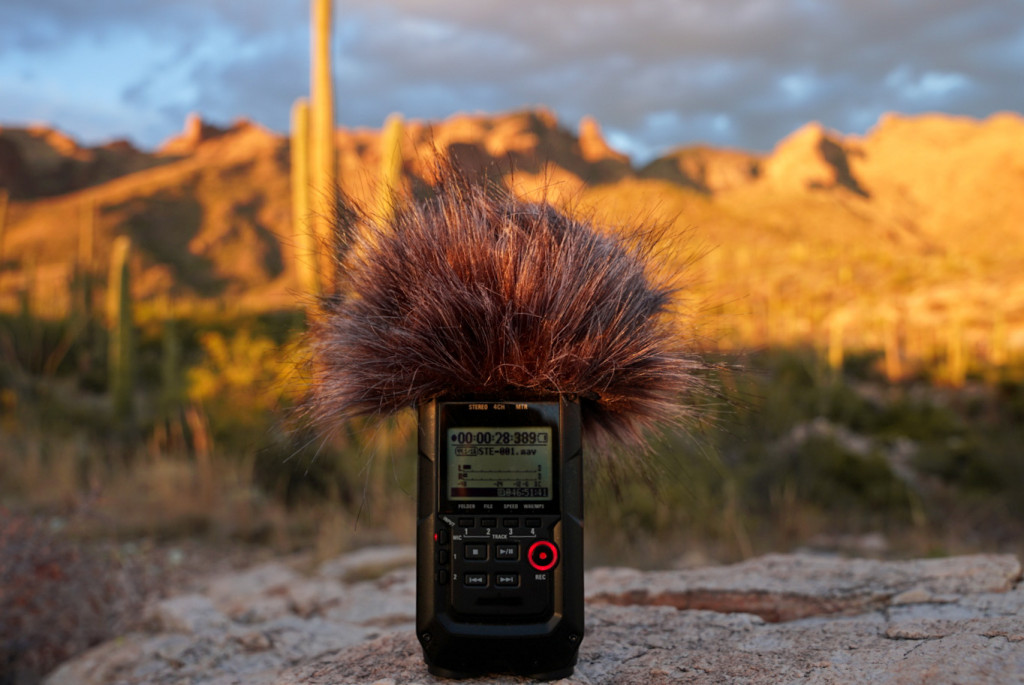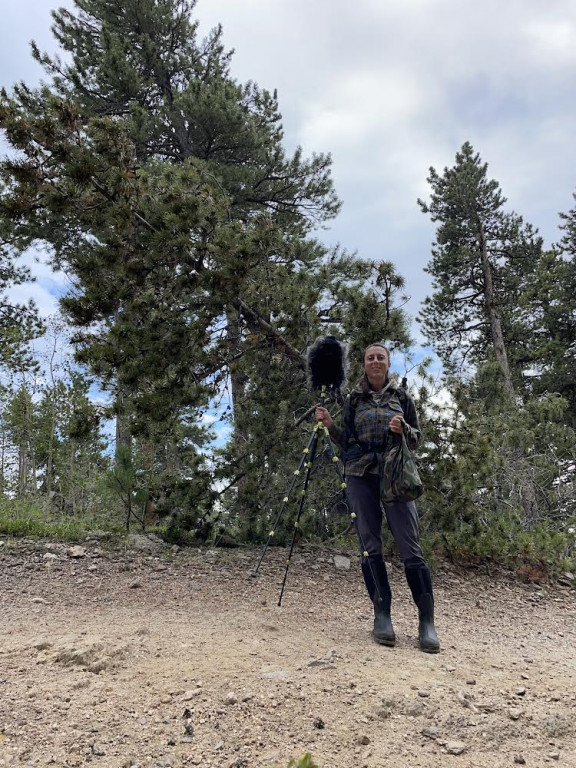
Listening to live or recorded natural sound can connect us and provide valuable information about the state of our environment. (Chris Zatarain)

Listening to live or recorded natural sound can connect us and provide valuable information about the state of our environment. (Chris Zatarain)
Audio Story by Chris Zatarain
When was the last time that you really, truly listened to your surroundings? Where were you? What did you hear? How did you feel?
We live in a bustling and noisy world, and I for one find that there is not much room left for stillness—to be present and to really stretch my ears out and listen, even though it seems like there is always something going on. It can be exhausting.
Maybe you can relate, but to me, a retreat into the wilderness is always a welcome reprieve from the constant boom and chatter that accompanies modern life. Trekking on a desert trail through Saguaro National Park or in Ponderosa pine forest on Mt. Lemmon gives me a new palette of sound to tune into:
Birdsong.
Wind in the trees.
The trickle of a waterfall tucked into the back of a quiet canyon.
I find it healing.

Our world is changing every day, and sometimes it seems that the sprawl of human life expands more and more, and nature can often feel farther and farther away.
In today’s conversation, I speak to Laura Gianonne, a field recording artist and acoustic ecology technician whose entire job is to listen to the natural world.
Laura travels the world capturing the sounds of vibrant ecosystems from the island of Borneo, to the jungles of Ecuador, Chichibu National park in Japan, and the shimmering dawn chorus of the Olympic peninsula, among others.

Her skills and talents are used both in scientific endeavors aiding research and organizations like Quiet Parks International and Bornean Bird Conservation, as well as to bring the peaceful, natural sounds of the world to the ears of weary listeners.
We discuss the ways that acoustic ecology can be used in conservation and land management strategies, as well as the ways in which the act of listening can bring us some peace as well.
You can learn more about Laura and listen to her beautiful field recordings, such as those featured in this audio piece, at ebbtidesound.com.
Full transcript below:
Chris Zatarain 0:00
What types of things can we learn when we listen to our environment? Today I’m speaking with someone whose entire livelihood is based on recording and listening to natural sound.
Laura Gianonne 0:25
My name is Laura Gianonne and I work as a sound engineer who specialized in field recording. And I also have a background in studying acoustic ecology. My college degree is from Evergreen State in Washington, and that’s where I lived for a long time enjoying the sounds of the forest there. I grew up in Southern California and moved up to Washington a little while after high school and then lived in a rural area worked on farms for a while and got involved in acoustic ecology community projects out on the Olympic Peninsula. Currently, I mostly work as a sound editor and recording nature sounds but I also volunteer or do projects for quiet parks International and I’ve done work with Forney and bird conservation as a student and I’m hoping to continue doing more field work with acoustic analysis and helping with the acoustic studies with that project again in the future.
Chris Zatarain 1:23
Great, so what is your favorite sound?
Laura Gianonne 1:26
Oh, that’s not fair. It would have to be waves. I grew up surfing. I don’t get to surf very much lately, but the sound of waves is really means a lot to me kind of cuts through to the soul for me.
Chris Zatarain 1:41
All right, can you in general terms describe what acoustic ecology is and how it relates to your work as a field Recordist and as an acoustic ecology technician?
Laura Gianonne 1:53
Sure, acoustic ecology is the field in which we study how beings relate to sound and their environment through sound. So I think maybe initially, the research was more focused on humans and the environment, and sound and how that you know, plays into how we feel in certain environments and things but there’s a lot of research about how animals and birds use sound to communicate and also how different kinds of sound affect their behavior. So like if there’s a new development that brings a lot more sound into a certain area. There are some studies and research on how that affects species in the area. So it’s, it’s a lot broader than just how it affects humans.
Chris Zatarain 2:42
So as a field Recordist what are some things that field recordings can tell us about the environment around us and the health of ecosystems?
Laura Gianonne 2:52
A couple of studies that I’ve helped with setting up recording devices that basically can stay out on like a tree for days or weeks. In those cases, we were studying birds, so which birds are singing at which times a day and using acoustic data to see if certain species are actually present for one thing, especially if they’re threatened species or protected in some way? And then how often are they there? And so you can really get a lot of information about who’s there and when they’re there, basically, and what they’re doing from the acoustic data. And I think of field recordings in the same way. But for research you can glean a ton of information about which species are doing what at what times day, which is a great data set to analyze the ecosystem there. In the Sonoran Desert, when I was recording there, in the spring, I was hoping to record birdsong is migratory birds were coming through and it was a particularly dry spring. So because it was dry, there wasn’t as much food for the birds essentially, so not as many plants were blooming, fewer insects were present. And so I didn’t hear a big variety of migratory birds like I would have if there had been more rain and more water to produce, you know, food for the birds, essentially, birds being an indication of where people might enjoy being like, you can tell that it’s a dry period because, you know, there aren’t living things like passing through here in as much abundance as they would be if there was more precipitation. So in that way, it’s a sign that you’re not going to find as much water as you might other times of the year or after more rainfall. It’s an indicator of what’s happening. In the environment. So like that dry spring example, if the season is changing, or if there’s a lower more rainfall than usual that’ll affect the whole food chain and birds are really like striking and like, you know, Audible, visible way to notice that you can notice plants flowering but if you notice that a certain bird that you normally see isn’t there regularly anymore, that can be a sign that something is shifted in the environment for that bird.
Chris Zatarain 5:18
So in your knowledge and your experience, can you give a description of some ways that natural soundscapes are changing and what is driving some of those changes?
Laura Gianonne 5:28
Sure, there is a really cool study 2020 to 2021 in San Francisco about white crown or white throated sparrows, and this study was about their vocalizations during that time. Period, and showed that their songs became more complex during the time period when there was less traffic noise. So the city had experienced a significant shift in noise levels like a lot of cities had during that time. And birds were able to sing more complexly and be heard by other birds, I think is the assumption. So like, they won’t do it unless there’s a you know, purpose in it like if the other bird can’t hear them. It’s not working. So I think the idea is, basically there was fewer layers of noise to compete with and so the birds could revert to more complex song types, which was really interesting. So I think that was a really acute example of how the layers of noise that we create through various you know, industries and transportation can affect the soundscape by pretty pretty dramatically. I think that the massive amount of development all over the world really affects the acoustics of all of these natural spaces and our own spaces. So anytime we’re paving a road, it affects how species move through wilderness and also creates this noise corridor. So I’ve seen that everywhere, basically, just constant development, and then more and more air traffic a s well, that sound is very pervasive because of the altitude and the loudness of the jet. And I think that it’s mostly just that we continue to expand our development. Basically, keep doing that everywhere. And in some cases, I think, you know, like, people need homes and, you know, industry and all these things. So I don’t think it’s necessarily a bad thing, that we’re developing spaces, but I don’t think noise is always considered or at a top priority over other things, I think, especially with certain kinds of air traffic, it’s pretty tough to restrict that in terms of the noise that it’s causing.
Chris Zatarain 7:42
Can you tell us a little bit about how the data collected in acoustic ecology can be used to help in conservation efforts or land management efforts?
Laura Gianonne 7:54
Yeah, there’s one example of a project that I helped with on the Olympic Peninsula, there’s been an increase of jet traffic because of a specific Navy project testing a certain a certain technique. So people have been trying to figure out or have been actually implementing different ways to monitor this for years now because of the huge impact it’s having on the community there. And so one study the researchers Lauren Keaney. And she basically just recorded different locations in the operation area for these flights, and then sorted through all of that data to identify which types of flights are happening and how loud they are. And that data has been used in the community discussion of the situation, but also in actual litigation. So she’s got this acoustic data set that she’s spent also a lot of time analyzing. And so it’s not just the data collection, but her work, doing statistics on it and and studying the data from that, that demonstrates what exactly is happening in terms of loudness and frequency of flights and then that can be used to make rules basically. And then Quiet Parks International is a similar concept. When we do surveys we’re looking at which types of noise is present and how long and how loud is it and that can be used to designate areas as quiet parks or quiet trails, or quiet urban parks. And so that data is used to basically highlight areas people can go to enjoy a place that’s pretty free from human caused noise, which is hard to find. So that’s being used in that way to help bring awareness of wilderness basically, but acoustic is really helpful in that way as well. It kind of adds to the thoroughness of detecting whether something’s there and then you can use that to say, Okay, this threatened species exists here. So we’re going to have this thinning process happen that’s going to bring in machinery and whatnot. It could affect the species and then that’s kind of a powerful way to adjust what’s being done with the land. And then in other ways it to us to document if a species is present, and if it’s a threatened or endangered species, and there are certain mandated protections for that species. So if you have acoustic data that proves that an endangered species is in a forest, and you also have that forest is slated to be thinned or logged. Then you have some information there to work with. Like you can detect species by doing visual surveys and, you know, there’s different kinds of methods for that.
Chris Zatarain 10:40
So why do you think it’s important to designate these specific quiet areas that people can go to and what are the benefits of being able to listen in these environments?
Laura Gianonne 10:54
I think that people have an opportunity to be in a place that doesn’t have layers of noise, where they can spend time hearing what a bird or an insect sounds like or a mammal or something or the wind through branches without having to listen over all this other noise. It just becomes a lot more clear what’s happening in the natural environment around you because you’re not having to strain to hear it over all the other stuff that we normally are exposed to. So I hope people can find places to go where they can have that experience and it can be a little bit unsettling at first because I feel like I get all of this, you know, if I’m in an urban environment where there’s a lot of sound sources that are quite loud like I get all of this information like that, and then I go into a space or a forest or something away from that, that doesn’t have it. And suddenly you have this whole different sensory experience. It’s very dramatically different than that kind of typical listening environment that I think most people are in most of the time. And then I mean, there are like natural acoustic environments like in tropical forests are really loud during the day. So or like heavy rain, you know, or in the desert out and storms and stuff. And there’s plenty of natural experiences that are very loud so it’s not all just like one Wren singing in the tree or something. But I think getting to hear that without all of the layers is a pretty special experience that people can have by moving away from those places that are more dense, but it’s sometimes hard to access it because it’s a long drive or flight or something.
Chris Zatarain 12:38
Yeah, I think that’s a really good point. And I think that that’s why things like field recordings can be so useful because they make natural sound a little more accessible. Where can people find and listen to more of your work?
Laura Gianonne 12:51
I have a website for my business called https://ebbtidesound.com/. And I also have a SoundCloud channel. So all of that you can access through my website.
Chris Zatarain 13:02
Awesome. Thank you so much, Laura.